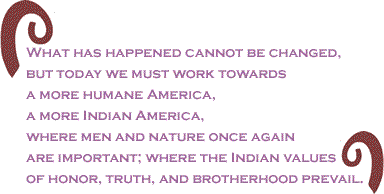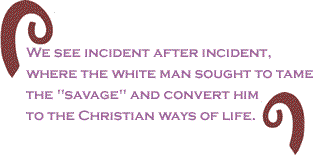| When
Frank James (1923 - February 20, 2001), known to the Wampanoag
people as Wampsutta, was invited to speak by the Commonwealth
of Massachusettsat the 1970 annual Thanksgiving feast at
Plymouth. When the text of Mr. James’ speech, a powerful
statement of anger at the history of oppression of the Native
people of America, became known before the event, the Commonwealth
"disinvited" him. Wampsutta was not prepared to
have his speech revised by the Pilgrims. He left the dinner
and the ceremonies and went to the hill near the statue
of the Massasoit, who as the leader of the Wampanoags when
the Pilgrims landed in their territory. There overlooking
Plymouth Harbor, he looked at the replica of the Mayflower.
It was there that he gave his speech that was to be given
to the Pilgrims and their guests. There eight or ten Indians
and their supporters listened in indignation as Frank talked
of the takeover of the Wampanoag tradition, culture, religion,
and land.
That
silencing of a strong and honest Native voice led to the
convening of the National Day of Mourning. The following
is the text of 1970 speech by Wampsutta, an Aquinnah Wampanoag
elder and Native American activist.
I
speak to you as a man -- a Wampanoag Man. I am a proud man,
proud of my ancestry, my accomplishments won by a strict
parental direction ("You must succeed - your face is
a different color in this small Cape Cod community!").
I am a product of poverty and discrimination from these
two social and economic diseases. I, and my brothers and
sisters, have painfully overcome, and to some extent we
have earned the respect of our community. We are Indians
first - but we are termed "good citizens." Sometimes
we are arrogant but only because society has pressured us
to be so.

It
is with mixed emotion that I stand here to share my thoughts.
This is a time of celebration for you - celebrating an anniversary
of a beginning for the white man in America. A time of looking
back, of reflection. It is with a heavy heart that I look
back upon what happened to my People.
Even
before the Pilgrims landed it was common practice for explorers
to capture Indians, take them to Europe and sell them as
slaves for 220 shillings apiece. The Pilgrims had hardly
explored the shores of Cape Cod for four days before they
had robbed the graves of my ancestors and stolen their corn
and beans. Mourt's Relation describes a searching party
of sixteen men. Mourt goes on to say that this party took
as much of the Indians' winter provisions as they were able
to carry.
Massasoit,
the great Sachem of the Wampanoag, knew these facts, yet
he and his People welcomed and befriended the settlers of
the Plymouth Plantation. Perhaps he did this because his
Tribe had been depleted by an epidemic. Or his knowledge
of the harsh oncoming winter was the reason for his peaceful
acceptance of these acts. This action by Massasoit was perhaps
our biggest mistake. We, the Wampanoag, welcomed you, the
white man, with open arms, little knowing that it was the
beginning of the end; that before 50 years were to pass,
the Wampanoag would no longer be a free people.

What
happened in those short 50 years? What has happened in the
last 300 years? History gives us facts and there were atrocities;
there were broken promises - and most of these centered
around land ownership. Among ourselves we understood that
there were boundaries, but never before had we had to deal
with fences and stone walls. But the white man had a need
to prove his worth by the amount of land that he owned.
Only ten years later, when the Puritans came, they treated
the Wampanoag with even less kindness in converting the
souls of the so-called "savages." Although the
Puritans were harsh to members of their own society, the
Indian was pressed between stone slabs and hanged as quickly
as any other "witch."
And
so down through the years there is record after record of
Indian lands taken and, in token, reservations set up for
him upon which to live. The Indian, having been stripped
of his power, could only stand by and watch while the white
man took his land and used it for his personal gain. This
the Indian could not understand; for to him, land was survival,
to farm, to hunt, to be enjoyed. It was not to be abused.
We see incident after incident, where the white man sought
to tame the "savage" and convert him to the Christian
ways of life. The early Pilgrim settlers led the Indian
to believe that if he did not behave, they would dig up
the ground and unleash the great epidemic again.
The
white man used the Indian's nautical skills and abilities.
They let him be only a seaman -- but never a captain. Time
and time again, in the white man's society, we Indians have
been termed "low man on the totem pole."
Has
the Wampanoag really disappeared? There is still an aura
of mystery. We know there was an epidemic that took many
Indian lives - some Wampanoags moved west and joined the
Cherokee and Cheyenne. They were forced to move. Some even
went north to Canada! Many Wampanoag put aside their Indian
heritage and accepted the white man's way for their own
survival. There are some Wampanoag who do not wish it known
they are Indian for social or economic reasons.
What
happened to those Wampanoags who chose to remain and live
among the early settlers? What kind of existence did they
live as "civilized" people? True, living was not
as complex as life today, but they dealt with the confusion
and the change. Honesty, trust, concern, pride, and politics
wove themselves in and out of their [the Wampanoags'] daily
living. Hence, he was termed crafty, cunning, rapacious,
and dirty.

History
wants us to believe that the Indian was a savage, illiterate,
uncivilized animal. A history that was written by an organized,
disciplined people, to expose us as an unorganized and undisciplined
entity. Two distinctly different cultures met. One thought
they must control life; the other believed life was to be
enjoyed, because nature decreed it. Let us remember, the
Indian is and was just as human as the white man. The Indian
feels pain, gets hurt, and becomes defensive, has dreams,
bears tragedy and failure, suffers from loneliness, needs
to cry as well as laugh. He, too, is often misunderstood.
The
white man in the presence of the Indian is still mystified
by his uncanny ability to make him feel uncomfortable. This
may be the image the white man has created of the Indian;
his "savageness" has boomeranged and isn't a mystery;
it is fear; fear of the Indian's temperament!
High
on a hill, overlooking the famed Plymouth Rock, stands the
statue of our great Sachem, Massasoit. Massasoit has stood
there many years in silence. We the descendants of this
great Sachem have been a silent people. The necessity of
making a living in this materialistic society of the white
man caused us to be silent. Today, I and many of my people
are choosing to face the truth. We ARE Indians!
Although
time has drained our culture, and our language is almost
extinct, we the Wampanoags still walk the lands of Massachusetts.
We may be fragmented, we may be confused. Many years have
passed since we have been a people together. Our lands were
invaded. We fought as hard to keep our land as you the whites
did to take our land away from us. We were conquered, we
became the American prisoners of war in many cases, and
wards of the United States Government, until only recently.

Our
spirit refuses to die. Yesterday we walked the woodland
paths and sandy trails. Today we must walk the macadam highways
and roads. We are uniting We're standing not in our wigwams
but in your concrete tent. We stand tall and proud, and
before too many moons pass we'll right the wrongs we have
allowed to happen to us.
We
forfeited our country. Our lands have fallen into the hands
of the aggressor. We have allowed the white man to keep
us on our knees. What has happened cannot be changed, but
today we must work towards a more humane America, a more
Indian America, where men and nature once again are important;
where the Indian values of honor, truth, and brotherhood
prevail.
You
the white man are celebrating an anniversary. We the Wampanoags
will help you celebrate in the concept of a beginning. It
was the beginning of a new life for the Pilgrims. Now, 350
years later it is a beginning of a new determination for
the original American: the American Indian.
There
are some factors concerning the Wampanoags and other Indians
across this vast nation. We now have 350 years of experience
living amongst the white man. We can now speak his language.
We can now think as a white man thinks. We can now compete
with him for the top jobs. We're being heard; we are now
being listened to. The important point is that along with
these necessities of everyday living, we still have the
spirit, we still have the unique culture, we still have
the will and, most important of all, the determination to
remain as Indians. We are determined, and our presence here
this evening is living testimony that this is only the beginning
of the American Indian, particularly the Wampanoag, to regain
the position in this country that is rightfully ours.
41st
National Day of Mourning 2010 |

